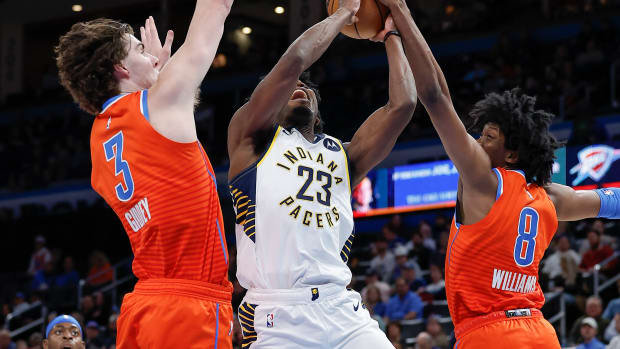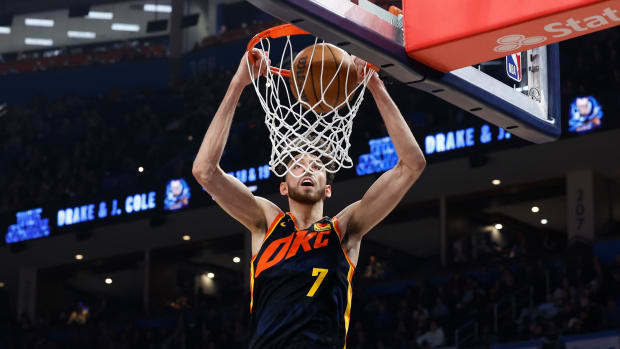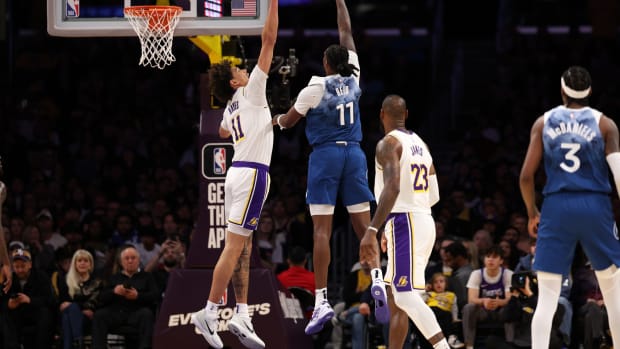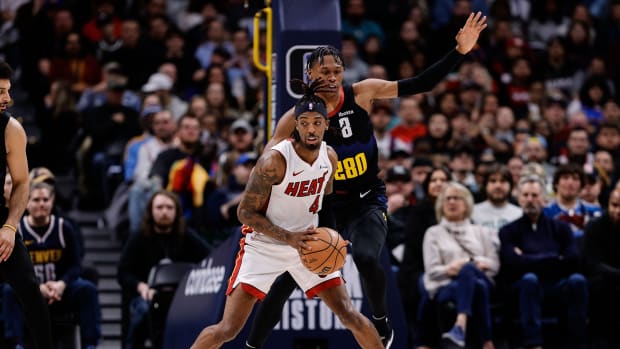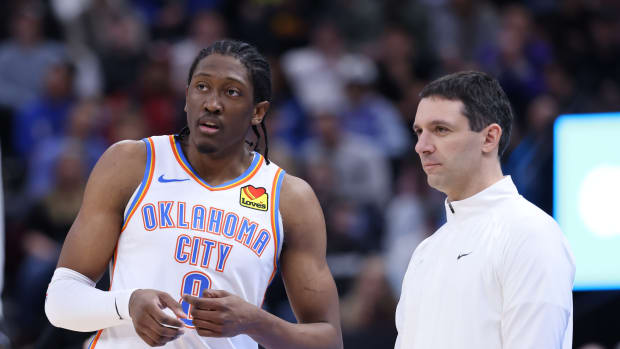Knicks' Win-Now Interests Clash With Kristaps Porzingis's Learning Curve
One of the tricky aspects of exceeding expectations—as Kristaps Porzingis so clearly did in his rookie campaign—is that it leaves a bulky organization to pivot around a revelation. Making changes from game to game is very much a part of NBA life, but structural decisions made long in advance each provide a sort of cultural friction. Players have been assured a certain kind of role. Coaches have preconceived notions of what a player should or shouldn't do. A particular system or playbook has already been championed. Order has been established with a certain ecosystem in mind from the very first days of training camp. In this case, even Porzingis himself had envisioned a slower, more gradual rise into quasi-stardom—a prospect smashed by his play virtually out of the gate.
"The first year was kind of hard for me," Porzingis told SI.com's DeAntae Prince. "There was just too much attention, too much going on and I really just wanted to focus on basketball. All these offers were coming in, especially when I started playing a little bit, because nobody was really expecting much from me. But once I started playing there was really a lot going on."
It took time for the Knicks to realize what a rare talent they had on their hands; an argument could also be made, based on their free-agent decisions and rotation patterns since, that they still haven't fully come to terms with it. But Porzingis settled in, and with even the slightest organization help has quickly built up his game. He is a more featured option, in a sense, but also one working in a more diverse offense given the reshaping of New York's roster.
Kristaps Porzingis Q&A: 'Nobody Was Really Expecting Much From Me'
Porzingis finds a way. Aligning Carmelo Anthony and Derrick Rose on the same team will inevitably leave shooters like Porzingis stranded off-ball for a certain dose of possessions. There will be minutes at a time where Porzingis doesn't get a touch or any kind of real scoring opportunity, and the Knicks' offense has proven relatively solid in spite of that. Credit Porzingis for knowing his shots and taking them with confidence when they come—and Knicks coach Jeff Hornacek for modernizing the team's approach to greater efficiency. The types of shots that Porzingis takes might not be dramatically different from before, but they come from a slightly different menu of actions and are unquestionably more oriented around creating open three-pointers.
It's jarring how often a simple pick-and-pop will leave Porzingis wide open at the top of the floor:
And at 7'3", stunting and late closeouts are rendered completely ineffective. A defender has to commit completely to running at Porzingis to have any chance of affecting his shot. Porzingis knows this, allowing him to confidently take jumpers a defense might try to scare him out of with half-measures or put his handles to work against hard-closing defenders. This is where the Dirk comparisons come in.
“We tell guys: ‘Don’t try to block Dirk’s shot; you’re not going to be able to block it. Just put your hand up and challenge it; he’s going to get it off no matter what,'" Hornacek said (via the New York Times). "That’s where we think K.P. can get to."
That unblockability is just one feature of Nowitzki's considerable offensive game, though it was an important cornerstone of his early skill set. A defender's desperation is fertile ground for developing counters. Porzingis already has a nice driving game for when defenders try to stick him too tightly:
And a wide, functional crossover that can displace opponents just enough to allow for a pull-up or runner:
It is genuinely insane that one would discuss the crossover as a real option for a player this tall. Frankly, it doesn't even look like it should work; years seem to pass in the span of the ball going from one hand to the floor to the other, and yet Porzingis is able to protect his dribble while actually using it to advance a play in progress. Comfort has played a big part in Porzingis getting the most out of even one or two dribbles. A contested three now easily and fluidly turns into a pull-up. A quick change of direction off the bounce allows Porzingis to steer his way around potential crowds. More angles are available to him because the very idea of putting the ball on the floor is more plausible. Such is the benefit of the year after the breakout; Porzingis knew what shots he could get and worked all summer to find ways to make more.
Those openings are invaluable given Porzingis's creative limitations. His handle might be good enough to sneak past unsuspecting bigs here and there, but it's not as if he can (or should) take a set defender off the dribble as a means to initiate offense. The post can be an option in some matchups, but Porzingis—who, to his credit, is a little tougher to knock off-base this season—doesn't quite have the strength or footwork to make a go of it consistently.
Playing alongside a guard of Rose's type, while undoubtedly frustrating in some respects, has also brought a nice counterweight to Porzingis's range. Rose is the sort of offensive lead who can't always be counted on to deliver the ball on-time or on-target, much less both. Yet he's been effective enough pushing past defenders this season to create compromises in the defense that benefit everyone around him. A downhill Rose (particularly since he's now finishing more effectively) strings out the two-man game in opposite directions. As Rose looks to dart toward the rim and Porzingis floats to the arc, defenders have to make a snap decision. Often they default by overreacting to Rose.
It should come as no surprise that Porzingis (regardless of whether he plays power forward or center) shoots his best with Rose on the floor. This is more indicative of his reliance on other creators and synergy with a certain type of guard than any statement on Rose in particular. What Rose has done is functional but unspectacular. What Porzingis contributes already, in tandem, is what makes New York viable.
Zinger! Kristaps Porzingis is silencing doubters and taking over New York
There's nothing wrong with this sort of role and utility; one can still engineer offense to get shots to a pick-and-pop threat like Porzingis, even when the possession doesn't begin with him. That dynamic does, however, somewhat complicate the idea that Anthony should cede to Porzingis as New York's primary shot-taker with a question of scaling. Scan the list of players who attempt more field goals per game than Porzingis. Every single one has a greater capacity to generate individual offense than Porzingis does currently, which makes siphoning attempts his way a bit complicated and, in an immediate sense, even a little counterproductive. Working through Porzingis makes more sense as a developmental exercise than an immediate resource. For a team with apparent win-now interests and a defense that leaves zero margin for error, it might not be entirely practical.
And really, there's no need to rush. Porzingis is already creature of myth, a potential All-Star, and a clear centerpiece for the franchise long-term. The diversity of his production leaves him destined to break Basketball-Reference's search functions. Filter down the league for shot-blockers among three-point shooters or shooters among giants based on Porzingis's particulars and you'll consistently find him in rare company. Porzingis has fast established himself as the champion of the five-block, three-trey game. One can only imagine the statistical oddities he'll collect as he ages into his prime, and the filters upon filters—all dictated by Porzingis's performance—that will leave him a world apart.































